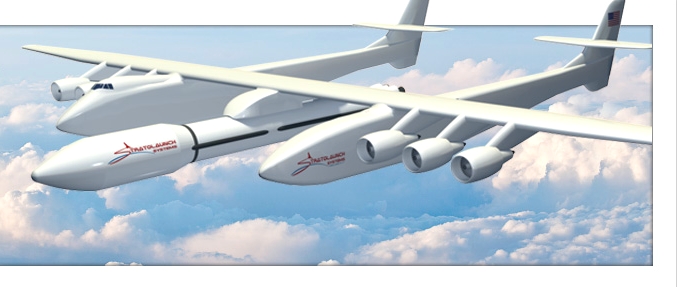Stratolaunch Systems, A Paul G. Allen Project
Entrepreneur, Microsoft Co-Founder and philanthropist Paul G. Allen and aerospace pioneer Burt Rutan have reunited to develop the next generation of space travel. Allen and Rutan, whose SpaceShipOne was the first privately-funded, manned rocket ship to fly beyond earth’s atmosphere, are developing a revolutionary approach to space transportation: Stratolaunch Systems – an air-launch system to provide orbital access to space with greater safety, cost-effectiveness and flexibility.
Stratolaunch Systems will bring airport-like operations to the launch of commercial and government payloads and, eventually, human missions. Plans call for a first flight within five years. The air-launch-to-orbit system will mean lower costs, greater safety, and more flexibility and responsiveness than is possible today with ground-based systems. Stratolaunch’s quick turnaround between launches will enable new orbital missions as well as break the logjam of missions queued up for launch facilities and a chance at space.
“I have long dreamed about taking the next big step in private space flight after the success of SpaceShipOne – to offer a flexible, orbital space delivery system,” Paul G.Allen said. “We are at the dawn of radical change in the space launch industry. Stratolaunch Systems is pioneering an innovative solution that will revolutionize space travel.”
To lead the Stratolaunch Systems team, Allen picked a veteran NASA official with years of experience in engineering, management and human spaceflight. Stratolaunch Systems CEO and President Gary Wentz, a former chief engineer at NASA, said the system’s design will revolutionize space travel.
Former NASA Administrator Mike Griffin, also a Stratolaunch board member, joined Allen and Rutan at a press conference in Seattle to announce the project. “We believe this technology has the potential to someday make spaceflight routine by removing many of the constraints associated with ground launched rockets,” Griffin said. “Our system will also provide the flexibility to launch from a large variety of locations.”
The Stratolaunch system will eventually have the capability of launching people into low earth orbit. But the company is taking a building block approach in development of the launch aircraft and booster, with initial efforts focused on unmanned payloads. Human flights will follow, after safety, reliability and operability are demonstrated.
Stratolaunch carrier aircraft will operate from a large airport/spaceport, such as Kennedy Space Center, and will be able to fly up to 1,300 nautical miles to the payload’s launch point.
It will use six 747 engines, have a gross weight of more than 1.2 million pounds and a wingspan of more than 380 feet. For takeoff and landing, it will require a runway 12,000 feet long. Systems onboard the launch aircraft will conduct the countdown and firing of the booster and will monitor the health of the orbital payload.
The plane will be built in a Stratolaunch hangar which will soon be under construction at the Mojave Air and Space Port. It will be near where Scaled Composites built SpaceShipOne which won Allen and Scaled Composites the $10-million Ansari X Prize in 2004 after three successful sub-orbital flights. Scaled Composites is a wholly owned subsidiary of Northrop Grumman.
[adsenseyu1]


